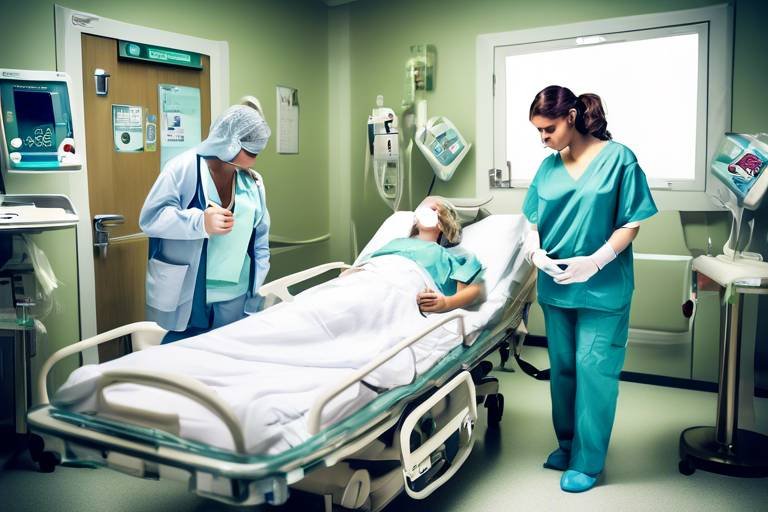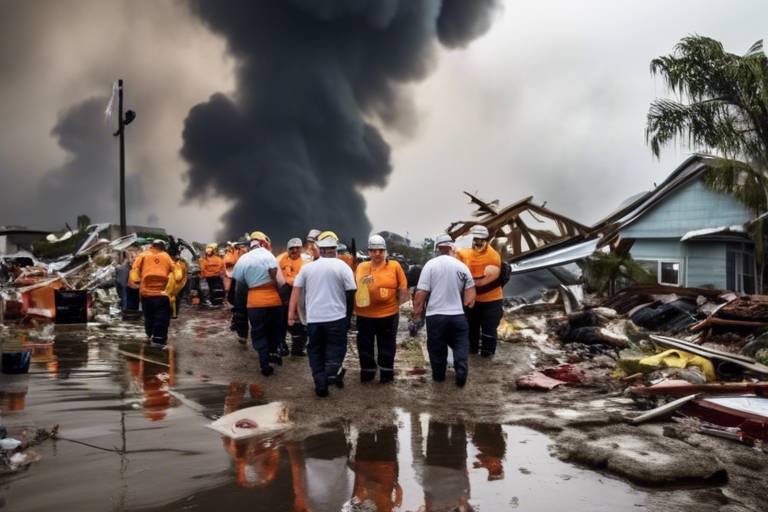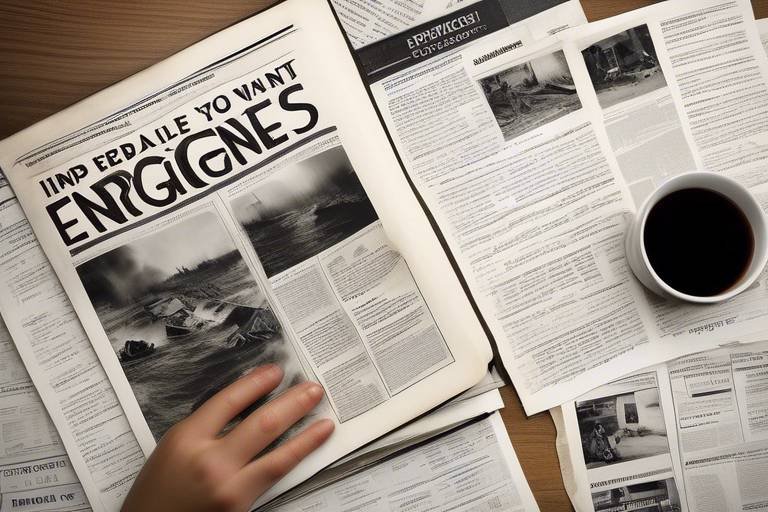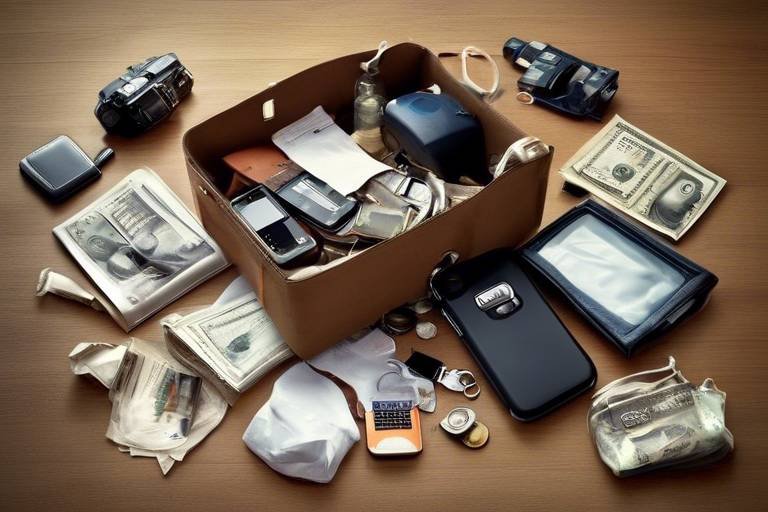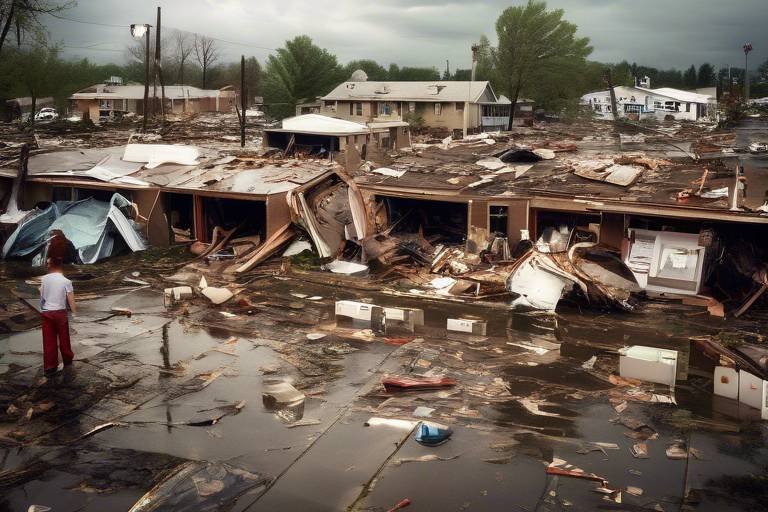Hospital Emergency Preparedness - What You Need to Know
In today's unpredictable world, the importance of hospital emergency preparedness cannot be overstated. Hospitals are not just places for healing; they are critical infrastructures that must be ready to face any crisis, whether it’s a natural disaster, a pandemic, or a mass casualty incident. Imagine a scenario where an earthquake strikes, leaving hundreds injured and in need of immediate medical attention. How would a hospital respond? The answer lies in their preparedness. This article outlines essential strategies and protocols that hospitals must implement to ensure readiness for emergencies, providing insights into how they can effectively manage crises when they occur.
Emergency preparedness in hospitals encompasses a wide range of activities, including planning, training, and resource allocation. It’s not just about having a plan on paper; it’s about creating a culture of readiness that permeates every level of the organization. When healthcare providers are trained and equipped to handle emergencies, they can respond swiftly and efficiently, ultimately saving lives. But what does this really mean? Think of it as a fire drill. Just as schools practice evacuating in case of a fire, hospitals must regularly rehearse their emergency protocols to ensure that every staff member knows their role when the unexpected occurs.
An effective emergency plan is like a well-oiled machine, consisting of several critical components that work together seamlessly. These include risk assessment, communication strategies, and resource management. Each element plays a vital role in creating a comprehensive emergency response framework. For instance, without a solid risk assessment, hospitals may overlook potential threats that could disrupt their operations. Similarly, poor communication can lead to chaos during a crisis, making it imperative to establish clear protocols. Let's delve deeper into these components to understand their significance.
Conducting a thorough risk assessment is the first step in identifying potential threats and vulnerabilities that a hospital may face. This involves evaluating both internal and external factors that could impact operations. Hospitals can employ various methodologies for this evaluation, including SWOT analysis (assessing strengths, weaknesses, opportunities, and threats) and scenario planning (imagining different crisis scenarios). By prioritizing preparedness efforts based on these assessments, hospitals can focus their resources on the most pressing risks.
Recognizing specific vulnerabilities within hospital systems is crucial for effective planning. Vulnerabilities can stem from outdated technology, insufficient staffing, or even geographical location. For example, a hospital located in a flood-prone area must have a different preparedness strategy compared to one situated in an earthquake zone. By identifying these weaknesses, hospitals can develop targeted interventions to mitigate risks. Common areas of vulnerability include:
- Infrastructure weaknesses
- Supply chain dependencies
- Staffing shortages
Once vulnerabilities are identified, it’s essential to prioritize risks to ensure that hospitals allocate their resources effectively. This involves ranking risks based on both their likelihood of occurrence and potential impact on operations. For instance, a hospital may determine that a pandemic poses a higher risk than a localized flooding event, thereby directing more resources towards pandemic preparedness. This process of prioritization is not static; it requires ongoing assessment and adjustment as new threats emerge.
Regular training and drills are vital for ensuring staff readiness during emergencies. Just as athletes train for competition, healthcare workers must engage in simulation exercises to practice their response to various scenarios. These drills not only enhance individual skills but also foster teamwork and communication among staff members. Ongoing education is equally important, as it keeps everyone informed of the latest protocols and technologies in emergency response. Imagine the confidence boost a nurse feels when they know exactly what to do during a crisis—it’s a game-changer!
Effective communication is essential during emergencies, both internally and externally. When chaos reigns, clear and consistent communication can be the difference between order and panic. Hospitals must develop strategies that ensure all staff members are informed and coordinated during a crisis. This includes establishing robust internal communication protocols, which can involve using dedicated communication tools and assigning roles to ensure that information flows smoothly.
Establishing internal communication protocols ensures that all staff members are on the same page during a crisis. Best practices include:
- Regular briefings and updates
- Utilizing technology for real-time communication
- Designating communication liaisons
These practices help to minimize confusion and ensure that everyone knows their responsibilities during an emergency.
Communicating with external stakeholders, including media and families, is critical during emergencies. Hospitals must manage external communications effectively to maintain public trust and provide accurate information. This involves preparing key messages in advance and designating spokespersons who can address the media and public inquiries. In times of crisis, misinformation can spread like wildfire, making it imperative for hospitals to control the narrative and keep the community informed.
Q: What are the main components of an emergency preparedness plan in hospitals?
A: The main components include risk assessment, communication strategies, resource management, and regular training and drills.
Q: How often should hospitals conduct emergency drills?
A: Hospitals should conduct emergency drills at least twice a year, but more frequent drills may be necessary depending on the specific risks they face.
Q: Why is communication so important during emergencies?
A: Effective communication ensures that all staff are informed, reduces panic, and helps maintain public trust during crises.

Understanding Emergency Preparedness
Emergency preparedness in hospitals is not just a checkbox on a to-do list; it’s a critical lifeline that can mean the difference between chaos and calm during a crisis. Imagine a hospital as a well-oiled machine, where every cog and wheel must work in harmony to respond effectively when disaster strikes. This involves meticulous planning, comprehensive training, and strategic resource allocation. The essence of preparedness is to ensure that healthcare facilities are ready to tackle a variety of emergencies, from natural disasters like hurricanes and earthquakes to pandemics and mass casualty incidents.
At its core, emergency preparedness encompasses several foundational concepts that are paramount in healthcare settings. First and foremost, it’s about anticipation. Hospitals must anticipate potential emergencies and develop protocols that can be swiftly implemented. This means conducting thorough assessments to identify the types of risks that could affect their operations. For instance, a hospital located in a flood-prone area must have a different plan compared to one situated in an earthquake zone. The ability to foresee these risks is crucial in crafting a robust emergency response plan.
Another vital aspect is training. Staff members need to be well-versed in emergency procedures. Regular drills and simulations are essential to prepare healthcare workers for real-life scenarios. Think of it this way: just like athletes practice their plays repeatedly to perform flawlessly during a game, hospital staff must also rehearse their emergency protocols to ensure they can act decisively when the stakes are high. This continuous education not only builds confidence but also fosters a culture of safety within the institution.
Moreover, resource allocation plays a significant role in emergency preparedness. Hospitals must ensure that they have the necessary supplies, equipment, and personnel ready to mobilize at a moment’s notice. This includes everything from medical supplies to communication tools. A well-prepared hospital is like a well-stocked pantry; when the unexpected happens, having the right resources on hand can make all the difference.
In summary, understanding emergency preparedness in hospitals is about much more than just having a plan. It’s about creating a resilient system that can withstand the pressures of unexpected events. By focusing on anticipation, training, and resource management, hospitals can ensure that they are not only prepared for emergencies but are also capable of providing the highest level of care when it matters most.

Key Components of an Emergency Plan
When it comes to emergency preparedness in hospitals, having a solid plan is not just a luxury—it's a necessity. An effective emergency plan serves as the backbone for a hospital's response to crises, whether they be natural disasters, pandemics, or mass casualty incidents. But what exactly makes up a comprehensive emergency plan? Let's dive into the key components that ensure hospitals are ready to tackle any situation head-on.
First and foremost, a thorough risk assessment is crucial. This involves identifying potential threats and understanding the vulnerabilities of the hospital's infrastructure and systems. By evaluating these risks, hospitals can prioritize their preparedness efforts. For instance, they may find that certain areas, such as the emergency department or intensive care unit, are more susceptible to overwhelming demand during a crisis. Recognizing these factors allows for targeted resource allocation.
Next, we have communication strategies. Effective communication is the lifeblood of any emergency response. Hospitals must establish clear protocols to ensure that all staff members are on the same page during a crisis. This includes everything from internal communication among healthcare providers to external communication with patients, families, and the media. A well-structured communication plan can significantly reduce confusion and misinformation, enabling a smoother response.
Another vital component is resource management. This encompasses not only the physical resources—like medical supplies and equipment—but also human resources. Hospitals need to ensure they have enough staff on hand, and that those staff members are adequately trained to handle emergencies. Resource management also includes maintaining an inventory of necessary supplies and ensuring that they are accessible when needed. After all, what good is a plan if you don’t have the means to execute it?
Lastly, a successful emergency plan incorporates training and drills. Regular training sessions and simulation exercises help familiarize staff with emergency protocols, ensuring they know what to do when the time comes. These drills can range from simple tabletop exercises to full-scale simulations that mimic real-life scenarios. The goal is to create muscle memory and build confidence among staff, so they can act decisively and efficiently under pressure.
In summary, the key components of an emergency plan include:
- Risk Assessment: Identifying and evaluating potential threats and vulnerabilities.
- Communication Strategies: Establishing clear internal and external communication protocols.
- Resource Management: Ensuring adequate supplies and trained personnel are available.
- Training and Drills: Conducting regular exercises to prepare staff for emergencies.
By focusing on these components, hospitals can create a robust emergency plan that not only prepares them for the unexpected but also instills confidence in their staff and the communities they serve. After all, in the world of healthcare, being prepared can mean the difference between life and death.

Risk Assessment Strategies
When it comes to emergency preparedness in hospitals, risk assessment is the cornerstone of a solid strategy. Think of it as the hospital's way of playing detective, sifting through potential threats and vulnerabilities to uncover what could go wrong. By conducting a thorough risk assessment, hospitals can identify a wide array of potential crises, from natural disasters like hurricanes and earthquakes to man-made emergencies such as mass casualty incidents or pandemics. This proactive approach not only helps in preparing for the worst but also ensures that resources are allocated effectively to mitigate those risks.
One of the most effective methodologies for evaluating risks is the Hazard Vulnerability Analysis (HVA). This systematic process allows hospitals to assess various hazards based on their likelihood and potential impact. By analyzing historical data and current trends, hospitals can prioritize which risks need immediate attention. For instance, if a hospital is located in a flood-prone area, it would be prudent to invest in flood mitigation strategies rather than focusing solely on less likely events like an earthquake.
Moreover, it’s crucial to recognize specific vulnerabilities within hospital systems. These vulnerabilities can often be the weak links that, if left unaddressed, could lead to catastrophic failures during an emergency. Common areas of weakness might include:
- Inadequate staffing during peak emergencies
- Insufficient medical supplies and equipment
- Outdated technology and communication systems
By identifying these vulnerabilities, hospitals can tailor their emergency plans to address them directly. For example, if a hospital identifies staffing shortages as a critical vulnerability, they might implement a cross-training program to ensure that all staff members are equipped to handle multiple roles during a crisis.
After identifying vulnerabilities, the next step is prioritizing risks. This process involves ranking the identified risks based on their likelihood of occurrence and the potential impact they could have on hospital operations. A simple yet effective way to visualize this is by using a risk matrix, which categorizes risks into levels such as low, medium, and high. This allows decision-makers to focus their attention on the most pressing threats while developing strategies for less likely scenarios.
| Risk Level | Likelihood | Impact | Action Required |
|---|---|---|---|
| High | Very Likely | Severe | Immediate Action Required |
| Medium | Possible | Moderate | Monitor and Prepare |
| Low | Unlikely | Minor | Review Periodically |
In conclusion, effective risk assessment strategies are not just about identifying what could go wrong; they are about empowering hospitals to take action before emergencies strike. By understanding vulnerabilities and prioritizing risks, healthcare facilities can create tailored emergency plans that not only protect patients and staff but also enhance overall community resilience. After all, in the world of healthcare, being prepared is not just a strategy; it's a lifesaving necessity.

Identifying Vulnerabilities
When it comes to emergency preparedness in hospitals, identifying vulnerabilities is like shining a flashlight into the dark corners of your organization. You might think everything is running smoothly, but lurking shadows can hide serious risks. Vulnerabilities can manifest in various forms, from outdated equipment and insufficient training to gaps in communication systems. It's essential to take a comprehensive approach to uncover these weaknesses, ensuring that your hospital is not just reactive but proactively prepared.
One effective method for identifying vulnerabilities is conducting a thorough risk assessment. This process involves analyzing every aspect of your hospital's operations, including:
- Infrastructure: Are your facilities equipped to handle a sudden influx of patients during a crisis?
- Staffing: Do you have enough trained personnel available at all times?
- Technology: Is your communication system robust enough to handle emergencies?
Moreover, it’s crucial to engage different departments in this assessment. For instance, the emergency department may have insights into patient flow issues, while the IT department can highlight potential cybersecurity threats. By fostering a culture of open communication and collaboration, hospitals can gather a holistic view of their vulnerabilities.
Another layer to consider is the physical environment. Natural disasters like earthquakes or floods can expose weaknesses in building design or emergency exits. Hospitals should evaluate their facilities against local hazard assessments to ensure that their infrastructure can withstand such events. For example, if your hospital is in a flood-prone area, you might need to invest in flood barriers or improve drainage systems.
Lastly, don't overlook the human factor. Staff members may not be aware of their roles during an emergency if they haven't been adequately trained. Regular drills and training sessions can help identify knowledge gaps and ensure that everyone knows what to do when the time comes. After all, a well-prepared staff is your first line of defense in any emergency situation.
In summary, identifying vulnerabilities is a multi-faceted process that requires a keen eye and a collaborative approach. By assessing infrastructure, engaging various departments, evaluating environmental risks, and training staff, hospitals can create a robust foundation for emergency preparedness.

Prioritizing Risks
Once vulnerabilities within a hospital's infrastructure have been identified, the next crucial step is . This process is not just about recognizing what could go wrong; it’s about determining which risks pose the most significant threat to patient safety, staff well-being, and operational continuity. Think of it like a game of chess: you need to anticipate your opponent's moves and decide which pieces to protect first. In the context of emergency preparedness, this means evaluating risks based on two primary factors: likelihood and potential impact.
To effectively prioritize risks, hospitals can employ a systematic approach. First, they should categorize risks into a risk matrix, which helps visualize and assess the severity of each risk. The matrix typically includes two axes: one for the probability of occurrence and another for the severity of consequences. By plotting risks on this matrix, hospitals can quickly identify which risks require immediate attention and resources.
| Risk Level | Probability | Impact | Action Required |
|---|---|---|---|
| High | Likely | Severe | Immediate action needed |
| Medium | Possible | Moderate | Plan for mitigation |
| Low | Unlikely | Minor | Monitor and review |
After plotting risks on the matrix, hospitals should focus on the high-risk areas. These are the scenarios that could lead to catastrophic outcomes if not addressed promptly. For example, if a hospital identifies that a natural disaster like a hurricane is likely to occur and could severely disrupt operations, it should prioritize developing a robust disaster response plan. Conversely, lower-priority risks, while still important, might only require monitoring or a less immediate response.
Another essential aspect of prioritizing risks is involving a diverse range of stakeholders in the process. This includes not just the hospital administration but also frontline staff, emergency responders, and even patients. Their insights can provide valuable perspectives on which risks are most concerning and why. By fostering a culture of open communication and collaboration, hospitals can ensure that their risk prioritization is comprehensive and reflective of the realities on the ground.
In summary, prioritizing risks is a vital component of effective emergency preparedness in hospitals. It allows for the strategic allocation of resources and ensures that the most pressing threats are addressed first. By employing a systematic approach, utilizing tools like risk matrices, and involving various stakeholders, hospitals can create a resilient framework that not only protects lives but also enhances overall operational efficiency.
- What is the purpose of risk prioritization in hospitals? Risk prioritization helps hospitals focus on the most significant threats to patient safety and operational continuity, ensuring resources are allocated effectively.
- How often should hospitals reassess their risks? Hospitals should regularly reassess their risks, especially after significant events or changes in operations, to ensure their emergency plans remain relevant.
- Who should be involved in the risk prioritization process? A diverse group of stakeholders, including hospital administration, frontline staff, emergency responders, and patients, should be involved to gain comprehensive insights.

Training and Drills
When it comes to hospital emergency preparedness, are not just optional; they are absolutely essential. Think of them as the fire drills we all remember from school—repetitive, sometimes tedious, but ultimately lifesaving. In the chaotic environment of a hospital, being prepared can mean the difference between life and death. Staff must be ready to respond swiftly to any crisis, whether it’s a natural disaster, a pandemic outbreak, or a mass casualty incident.
Regular training sessions help ensure that all hospital personnel are familiar with emergency protocols and can execute them efficiently under pressure. These sessions should encompass a range of scenarios, simulating real-life emergencies to provide staff with hands-on experience. For instance, a hospital might conduct drills that mimic a sudden influx of patients following a catastrophic event. This allows staff to practice triage techniques, communication strategies, and coordination with various departments.
Moreover, ongoing education is crucial. The healthcare landscape is constantly evolving, with new technologies and protocols emerging regularly. As such, hospitals should not only conduct annual drills but also offer continuous education opportunities. This could include workshops, webinars, or even online courses that keep staff updated on the latest best practices for emergency response.
Another important aspect of training is the inclusion of all hospital staff, not just those in emergency response roles. Everyone from the front desk personnel to the janitorial staff should understand their role in an emergency. This comprehensive approach ensures that when a crisis strikes, every team member knows how to contribute effectively. To facilitate this, hospitals can implement a structured training schedule that covers:
- Basic first aid and CPR
- Evacuation procedures
- Communication protocols
- Use of emergency equipment
To evaluate the effectiveness of these training sessions, hospitals should conduct debriefings post-drill. This involves gathering feedback from participants to identify areas for improvement. By fostering an environment where staff feel comfortable discussing what went well and what didn’t, hospitals can continuously refine their emergency preparedness plans.
In conclusion, training and drills are the backbone of hospital emergency preparedness. They not only equip staff with the necessary skills but also build confidence, ensuring that when an emergency arises, the hospital can respond with precision and care. Remember, in the world of healthcare, being prepared is not just a task; it’s a commitment to patient safety and community resilience.
What types of emergencies should hospitals prepare for?
Hospitals should prepare for a wide range of emergencies, including natural disasters (like hurricanes and earthquakes), pandemics, mass casualty incidents, and internal crises (such as fires or power outages).
How often should training and drills be conducted?
Training and drills should be conducted regularly, ideally at least once a year, with additional sessions for new staff or when new protocols are introduced.
Who should participate in emergency training?
All hospital staff, including administrative personnel, clinical staff, and support staff, should participate in emergency training to ensure a coordinated response during a crisis.
What is the role of debriefings after drills?
Debriefings provide an opportunity for participants to discuss the drill, share feedback, and identify areas for improvement, which is crucial for refining emergency preparedness plans.

Communication in Emergencies
When disaster strikes, whether it’s a natural calamity, a pandemic, or a mass casualty incident, the way a hospital communicates can make or break its ability to respond effectively. Effective communication is not just a nice-to-have; it’s a lifeline that ensures everyone—from healthcare providers to patients and their families—stays informed and coordinated. Imagine a ship in a storm; without a clear captain's voice guiding the crew, chaos can ensue. Similarly, in a hospital, clear communication can steer the ship through turbulent waters.
To facilitate smooth operations during crises, hospitals must establish a comprehensive communication strategy that encompasses both internal and external channels. Internally, it’s crucial to have protocols that keep all staff members in the loop. This means not just sending out an email and hoping everyone reads it, but implementing a system that allows for real-time updates. For instance, using tools like instant messaging apps or dedicated emergency communication platforms ensures that everyone gets the information they need when they need it. Imagine a nurse on the floor receiving immediate updates about changes in patient status or new protocols via a secure messaging app; this can significantly enhance patient care and safety.
On the external front, hospitals must be prepared to communicate effectively with families, the media, and other stakeholders. When a crisis unfolds, families are often anxious and seeking information about their loved ones. Hospitals should have designated spokespeople trained to handle media inquiries and provide timely updates to the public. This not only helps in managing the hospital’s reputation but also keeps the community informed. A well-prepared hospital can turn what could be a chaotic media frenzy into a structured flow of information that reassures the public.
To summarize, effective communication during emergencies hinges on:
- Robust internal protocols that ensure all staff members are informed and can act swiftly.
- Clear external communication strategies that keep families and the media updated.
- Real-time information sharing through modern technology to enhance situational awareness.
Moreover, hospitals should conduct regular training sessions focused on communication strategies. Just like rehearsing for a play, these drills prepare staff for the real thing, ensuring that everyone knows their role and how to communicate effectively under pressure. By investing in these training sessions, hospitals can cultivate a culture of preparedness, where every team member feels empowered to speak up and share critical information during emergencies.
Q: Why is communication so important during emergencies in hospitals?
A: Communication is vital because it ensures that everyone is informed and can act quickly. It helps manage chaos, keeps patients and families updated, and maintains the hospital's reputation.
Q: What tools can hospitals use for effective communication during emergencies?
A: Hospitals can utilize instant messaging apps, dedicated emergency communication platforms, and public announcement systems to ensure real-time information sharing.
Q: How often should hospitals conduct communication training?
A: Regular training should be conducted at least bi-annually, with additional drills scheduled as needed, especially during high-risk seasons or following significant incidents.

Internal Communication Protocols
When an emergency strikes, the clock is ticking, and every second counts. This is why having robust in place is not just a good idea—it's absolutely essential. Hospitals are bustling environments, and during a crisis, the chaos can escalate quickly. Clear communication can be the difference between a smooth response and a disastrous one. So, what does effective internal communication look like in a hospital setting?
First and foremost, establishing a clear chain of command is crucial. Everyone needs to know who is in charge and what their responsibilities are. This hierarchy not only helps in decision-making but also ensures that information flows smoothly from the top down. For instance, during a mass casualty incident, the emergency department head should be the main point of contact, relaying information to the staff and coordinating with other departments.
Additionally, hospitals should adopt a multi-channel communication strategy. Relying on a single method, such as emails or intercoms, can lead to information bottlenecks. Instead, consider the following channels:
- Two-way radios: These allow for instant communication among staff, especially in high-pressure situations.
- Mobile apps: Dedicated apps can provide real-time updates and notifications to all staff members.
- Text messaging: Quick text alerts can be sent out for urgent updates.
Moreover, conducting regular training sessions and simulations can significantly enhance communication effectiveness. These drills not only familiarize staff with protocols but also highlight any gaps in communication that need addressing. For example, if a particular message doesn’t reach a critical department during a drill, it’s an opportunity to refine the process before a real crisis occurs.
Another vital aspect of internal communication is ensuring that all staff members have access to the same information. This means that whether you’re a doctor, nurse, or administrative staff, everyone should be on the same page. Utilizing a centralized information system can help achieve this. Imagine a scenario where a sudden influx of patients occurs; having a shared platform where updates are posted can keep everyone informed and ready to act.
Finally, feedback loops are essential. After every drill or real emergency, staff should have the opportunity to provide feedback on the communication protocols. Were the messages clear? Did everyone understand their roles? This ongoing evaluation helps to continuously improve the internal communication strategy, ensuring that the hospital is always prepared for the unexpected.
In conclusion, effective internal communication protocols are the backbone of emergency preparedness in hospitals. By establishing a clear chain of command, utilizing multiple communication channels, conducting regular training, ensuring access to information, and fostering feedback, hospitals can enhance their response capabilities and ultimately save lives.
- What are internal communication protocols?
Internal communication protocols refer to the structured methods and channels used within a hospital to convey information, especially during emergencies. - Why is a chain of command important?
A clear chain of command helps in efficient decision-making and ensures that everyone knows their responsibilities during a crisis. - How can technology improve communication?
Utilizing tools like two-way radios, mobile apps, and text messaging can streamline communication and provide real-time updates during emergencies. - What role do training and drills play?
Regular training and simulations help staff familiarize themselves with protocols and identify areas for improvement in communication.

External Communication Strategies
When the storm hits or disaster strikes, the last thing you want is chaos in communication. Effective external communication is not just a nice-to-have; it’s a lifeline that can make or break a hospital's response during emergencies. Imagine a scenario where families are anxious, the media is buzzing, and the community is watching closely. How do you keep everyone informed and calm? It all comes down to having a solid communication strategy in place.
First and foremost, establishing a clear chain of command is essential. You need to know who is responsible for communicating with whom. This clarity helps prevent mixed messages and ensures that everyone is on the same page. For instance, you might designate a specific spokesperson who is trained to handle media inquiries and public statements. This individual should be well-versed in the hospital’s protocols and equipped to provide accurate information swiftly.
In addition to appointing a spokesperson, consider the channels through which you will disseminate information. Whether it’s a press release, social media updates, or direct communication with local authorities, each platform has its strengths. For example:
- Social Media: Quick updates can reach a large audience in real-time, making it a powerful tool for immediate communication.
- Press Releases: These are essential for formal announcements and can help control the narrative during a crisis.
- Community Meetings: Engaging directly with the public can foster trust and transparency.
Another critical aspect of external communication is ensuring that information is accessible to everyone. This means considering language barriers, literacy levels, and the needs of individuals with disabilities. Providing information in multiple languages and formats can significantly enhance understanding and trust within the community.
Moreover, regular updates are vital. During a crisis, people crave information. Even if there’s nothing new to report, a brief update can reassure the public that the situation is being monitored and managed. Implementing a system for regular updates can help keep anxiety at bay and maintain public trust.
Lastly, it’s important to gather feedback after the emergency has passed. Evaluating how effective your external communication strategies were can provide valuable insights for future preparedness efforts. Consider conducting surveys or holding debrief meetings with staff and community members to understand what worked and what could be improved.
Q1: Why is external communication important during emergencies?
A1: External communication is crucial as it helps keep the community informed, reduces panic, and ensures that accurate information is disseminated quickly.
Q2: Who should be responsible for external communication?
A2: A designated spokesperson should be appointed to handle all external communications to ensure consistency and clarity in messaging.
Q3: How can hospitals ensure that their messages reach everyone?
A3: By using multiple communication channels and providing information in various formats and languages, hospitals can ensure their messages are accessible to a broader audience.
Frequently Asked Questions
- What is emergency preparedness in hospitals?
Emergency preparedness in hospitals refers to the planning, training, and resource allocation needed to effectively respond to crises, such as natural disasters, pandemics, or mass casualty incidents. It's all about being ready to tackle unforeseen challenges and ensuring patient safety.
- Why is a risk assessment important?
A risk assessment is crucial because it helps hospitals identify potential threats and vulnerabilities within their systems. By understanding these risks, hospitals can prioritize their preparedness efforts and allocate resources more effectively, ensuring a stronger response when emergencies arise.
- How often should training and drills be conducted?
Training and drills should be conducted regularly, ideally at least twice a year. This ongoing education helps staff stay sharp and ready to respond efficiently during emergencies. Think of it as a sports team practicing plays to ensure they perform flawlessly during the big game!
- What are internal communication protocols?
Internal communication protocols are established methods for ensuring that all hospital staff members are informed and coordinated during a crisis. This includes clear channels for relaying information, updates, and instructions, which is vital for a smooth and effective response.
- How can hospitals communicate with external stakeholders during emergencies?
Hospitals can communicate with external stakeholders, such as media and families, by having a well-defined external communication strategy. This includes preparing press releases, designating spokespersons, and utilizing social media to provide timely updates while managing public perception effectively.
- What common vulnerabilities should hospitals focus on?
Common vulnerabilities include inadequate staffing, outdated equipment, and insufficient emergency supplies. By identifying and addressing these weaknesses, hospitals can strengthen their emergency preparedness and response capabilities.
- What role does resource management play in emergency preparedness?
Resource management is essential in emergency preparedness as it involves ensuring that the necessary supplies, equipment, and personnel are available and ready to be deployed during a crisis. Efficient management can make the difference between a chaotic response and a well-orchestrated effort.

